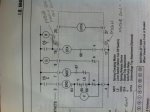Typically, the anti-pumping relay Y in cb control schemes picks-up through an auxiliary contact of the MR motor relay or of the spring-charge status mechanism (for example: see control diagram for Square D model VAD-3 vacuum breaker).
Question: what is the logic behind this implementation - would it not be more reasonable to pick-up the Y relay through a 52a n/o auxiliary switch of the breaker itself?
Question: what is the logic behind this implementation - would it not be more reasonable to pick-up the Y relay through a 52a n/o auxiliary switch of the breaker itself?


